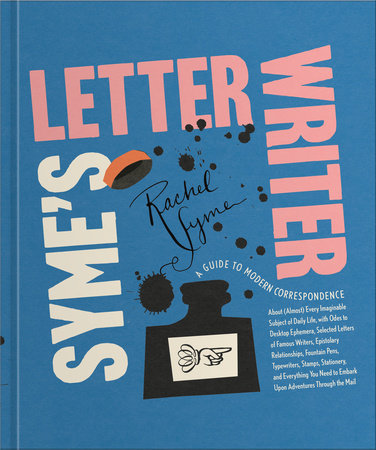Dear Reader (OR HOW TO USE THIS BOOK)
In 1867, the natty New York–based publisher Dick & Fitzgerald put out a chunky little book called
Frost’s Original Letter-Writer by an author who went by the mysterious pen name S. A. Frost. The actual author of the book, an exhaustive, punctilious guide to all things written correspondence, was an enterprising woman named Sarah Annie Frost (and who later went by Mrs. Sarah Annie Frost-Shields). Little is known about Frost’s personal life, save for the fact that she had an innate entrepreneurial streak—a rare trait for a Victorian housewife—and built herself a lucrative little publishing empire by pumping out several volumes of persnickety lifestyle manuals. In 1869, three years before Emily Post was even born, Frost wrote
Frost’s Laws and by-Laws of American Society, in which she laid out concise, confident, and often fully nutball etiquette tips for every situation from baptisms to bruncheons to bath time. (My favorite of her absurdist bathing rules: “Cold water refreshes and invigorates but does not cleanse; those persons, therefore, who daily use a cold bath in the morning should frequently use a warm one at night.”) The Victorians were big on protocol; they never met a draconian dictum that didn’t excite them a bit in the bloomers. Tell a Victorian that they have to learn six new ways to hold a teacup by sundown and they’ll say, “
Don’t threaten me with a good time.” Sarah Annie Frost was more than happy to serve as a kind of marmish domme of the domestic sphere, rapping the collective knuckles of those who had not yet learned that the best way to wash the hair is with a slurry of raw egg yolk and lime juice.
I came across a copy of Frost’s
Original Letter-Writer online in the summer of 2020, when I had just started to write a lot of letters to strangers on my hideous, beige beater of an electric typewriter from the 1980s (she is a Nakajima AE-710 and I love her very much, and you will learn more about why in the Typewriters section later in this book; see page 162). I was on the hunt for the history of letter-writing, and my explorations led me down a rabbit hole that ended in Frost’s guide, one of the first books to formally lay out tips and tricks of the mail-sending trade.
Frost’s suggestions are hilariously outdated (I don’t imagine many people today using her form letter for “answering an advertisement for a chambermaid”), but some of her wisdom holds up, such as her advice that using quotations or song lyrics in a letter feels twee and cheap (“Quotations should be used as a very rare luxury, as they are apt to give an appearance of pedantry and studied effect”) or her choice of writing instruments: “Never write in pencil. It is always careless, often rude.” Also, if you want to know how to send a truly creepy request to your fiancée asking for a lock of her hair while calling her a “stingy little pet,” well, Frost has that covered too.
I share with you the story of S. A. Frost (and my favorite excerpt is on the next page—a truly deranged and bitchy form letter in which a man advises a younger acquaintance to ditch a friend) to say that, for as long as people have been flinging paper back and forth through the postal service, they have been wondering if they are doing it right.
Cottage industries have sprung up like barnacles in Frost's wake, offering suggestions for how best to open a letter (Is it
Dear? Do people even say
dear anymore?) and how to close one (Is
XOXO too
Gossip Girl? Does
Warmly seem too tryhard or just tryhard enough? Would writing “All best” mark me as a sociopath?). Letters are such an intimate medium; they are meant for an audience of one. But, also, that one person will be spending a lot of time with whatever you send, poring over it with a hot beverage (or a cold cocktail) in hand. It makes sense that there is such public handwringing about such a private form. You want your letter to arrive at its destination, sure, but you also want it to really arrive. You want it to land. So people like Sarah Frost rush in to fill the void and to comfort the shaking hand over the blank page, ensuring nervous nellies that even a lackluster letter in the post is better than no letter at all.
I am, I admit, no Sarah Annie Frost-Shields. I have no hard-and-fast correspondence rules for you. I barely have any rules at all, except that you should apply the proper postage to your letters and learn how and when to use non-machinable stamps (and you will! See On Stamps on page 182). But this book is intended to be a nouveau
Frost’s Original Letter-Writer of sorts, one that takes Frost’s boundless energy for telling confused people what to do and updates it for the modern—and decidedly not letter-centric—era. If Frost were alive today, she’d probably have a very popular TikTok account or a correspondence-themed Substack (her book
The Art of Dressing Well does seem #cottagecore adjacent). But I have the pages of this book to work with, and I hope to provide a bit of structure around what I’ve learned when it comes to writing letters from the time I’ve spent on the PenPalooza project—a letter-exchange I launched on a whim during the early days of the pandemic that swelled to more than fifteen thousand members—and also from reading the correspondence of writers of the past. Like any good nineteenth-century prig, Sarah Frost did not trust anyone’s opinion but her own. I don’t possess so staunch an attitude. I have looked to other authors and poets and cooks and explorers and wanderers and the letters they have sent to inform my own how-tos—this is more of a group hymnal than a solo expedition.
The how-tos sprinkled throughout this book—How to Write a Postcard, How to Develop a Style in Your Correspondence, How to Write a Letter about Your Dreams, etc.—are meant as cheeky riffs on Frost’s formatting, but are far less rigid (you won’t find how to write a “Note Accompanying a Bouquet of Flowers to a Lady” here, or guidelines for a “Letter Recommending a Man Servant.”). Instead, they are merely intended to get you writing and to make you excited to sit down and compose a letter. We’ll explore how to write about a sumptuous meal, how to write a bitchy dispatch full of gossip and intrigue, and how to write about a beautiful spring day in a way that doesn’t just feel like snoozy small talk. Along the way, there will be writing prompts, excerpts from letters past, lists of truly good, not overly pretentious $10 words to drop into your prose, care package suggestions, and tips on how to properly scent a perfumed letter. You will also find my version of a field guide to all the tangible, physical, touchable, collectible, snacky things you can use to liven up a letter. Fountain pens! Stamps! Embossing guns! Types of envelopes (yes, it gets wild . . . )!
In the bygone days when letters were the only way to communicate from afar, writing out a long, meandering note and tucking it into a plain envelope was more than enough to deliver a thrill. Everyone was
so bored! Offering someone ten pages of scratchy handwriting that took the entire afternoon to read and broke up the monotony of the day? A
gift. When you see people squeal and rush to the door in period films when the Pony Express arrives, they are not necessarily overacting; receiving a piece of mail was perhaps the most exciting and exotic thing to happen to a person all week, maybe all month. Now, letters can barely compete with every other bit of stimulation flying at our faces, not because they have ceased to be thrilling, but because they have, for the most part, ceased to be at all.
There are so many reasons
not to send a letter—it takes too long, it’s unreliable, it requires scrounging up a stamp and a working pen, it might result in a hand cramp, it feels antiquated and unnatural and contrived. It’s so much easier and more efficient to just pick up the phone or send a text. But letters still serve a vital purpose, which is that they exist to mock the very idea of efficiency. They require slow, gear-crunching effort on both ends, for the writer
and for the reader (and for the many hands responsible for transporting the envelope in between the two). Letterwriting is a time-consuming rebuke to a world that tries to optimize every activity into a seamless slipstream, and there is joy to be had once you fully embrace the medium’s outdated extravagance. If you are going to put in the work to send a piece of mail, why not stuff the envelope so full of little treasures that you re-enchant the recipient to the surprising possibilities of the form?
Copyright © 2025 by Rachel Syme. All rights reserved. No part of this excerpt may be reproduced or reprinted without permission in writing from the publisher.























